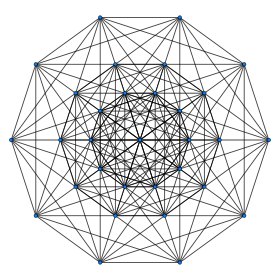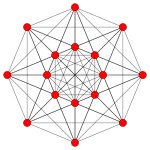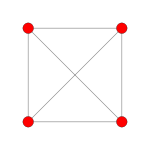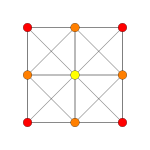- 6-demicube
-
Demihexeract
(6-demicube)
Petrie polygon projectionType Uniform 6-polytope Family demihypercube Schläfli symbol {3,33,1}
h{4,3,3,3,3}
s{2,2,2,2,2}Coxeter-Dynkin diagram 






























Coxeter symbol 131 5-faces 44 12 {31,2,1} 
32 {34}
4-faces 252 60 {31,1,1} 
192 {33}
Cells 640 160 {31,0,1} 
480 {3,3}
Faces 640 {3} 
Edges 240 Vertices 32 Vertex figure Rectified 5-simplex

Symmetry group D6, [35,1,1] = [1+,4,34]
[25]+Petrie polygon decagon Properties convex In geometry, a 6-demicube or demihexteract is a uniform 6-polytope, constructed from a 6-cube (hexeract) with alternate vertices deleted. It is part of a dimensionally infinite family of uniform polytopes called demihypercubes.
Coxeter named this polytope as 131 from its Coxeter-Dynkin diagram, with a ring on one of the 1-length Coxeter-Dynkin diagram branches. It can named similarly by a 3-dimensional exponential Schläfli symbol, {3,33,1}.
Contents
Cartesian coordinates
Cartesian coordinates for the vertices of a demihexeract centered at the origin are alternate halves of the hexeract:
- (±1,±1,±1,±1,±1,±1)
with an odd number of plus signs.
Images
orthographic projections Coxeter plane B6 Graph 
Dihedral symmetry [12/2] Coxeter plane D6 D5 Graph 

Dihedral symmetry [10] [8] Coxeter plane D4 D3 Graph 

Dihedral symmetry [6] [4] Coxeter plane A5 A3 Graph 

Dihedral symmetry [6] [4] Related polytopes
There are 47 uniform polytopes with D6 symmetry, 31 are shared by the B6 symmetry, and 16 are unique:

t0(131)
t0,1(131)
t0,2(131)
t0,3(131)
t0,4(131)
t0,1,2(131)
t0,1,3(131)
t0,1,4(131)
t0,2,3(131)
t0,2,4(131)
t0,3,4(131)
t0,1,2,3(131)
t0,1,2,4(131)
t0,1,3,4(131)
t0,2,3,4(131)
t0,1,2,3,4(131)References
- H.S.M. Coxeter:
- Coxeter, Regular Polytopes, (3rd edition, 1973), Dover edition, ISBN 0-486-61480-8, p.296, Table I (iii): Regular Polytopes, three regular polytopes in n-dimensions (n≥5)
- H.S.M. Coxeter, Regular Polytopes, 3rd Edition, Dover New York, 1973, p.296, Table I (iii): Regular Polytopes, three regular polytopes in n-dimensions (n≥5)
- Kaleidoscopes: Selected Writings of H.S.M. Coxeter, editied by F. Arthur Sherk, Peter McMullen, Anthony C. Thompson, Asia Ivic Weiss, Wiley-Interscience Publication, 1995, ISBN 978-0-471-01003-6 [1]
- (Paper 22) H.S.M. Coxeter, Regular and Semi Regular Polytopes I, [Math. Zeit. 46 (1940) 380-407, MR 2,10]
- (Paper 23) H.S.M. Coxeter, Regular and Semi-Regular Polytopes II, [Math. Zeit. 188 (1985) 559-591]
- (Paper 24) H.S.M. Coxeter, Regular and Semi-Regular Polytopes III, [Math. Zeit. 200 (1988) 3-45]
- John H. Conway, Heidi Burgiel, Chaim Goodman-Strass, The Symmetries of Things 2008, ISBN 978-1-56881-220-5 (Chapter 26. pp. 409: Hemicubes: 1n1)
- Richard Klitzing, 6D uniform polytopes (polypeta), x3o3o *b3o3o3o – hax
External links
- Olshevsky, George, Demihexeract at Glossary for Hyperspace.
- Multi-dimensional Glossary
Fundamental convex regular and uniform polytopes in dimensions 2–10 Family An BCn Dn E6 / E7 / E8 / F4 / G2 Hn Regular polygon Triangle Square Hexagon Pentagon Uniform polyhedron Tetrahedron Octahedron • Cube Demicube Dodecahedron • Icosahedron Uniform polychoron 5-cell 16-cell • Tesseract Demitesseract 24-cell 120-cell • 600-cell Uniform 5-polytope 5-simplex 5-orthoplex • 5-cube 5-demicube Uniform 6-polytope 6-simplex 6-orthoplex • 6-cube 6-demicube 122 • 221 Uniform 7-polytope 7-simplex 7-orthoplex • 7-cube 7-demicube 132 • 231 • 321 Uniform 8-polytope 8-simplex 8-orthoplex • 8-cube 8-demicube 142 • 241 • 421 Uniform 9-polytope 9-simplex 9-orthoplex • 9-cube 9-demicube Uniform 10-polytope 10-simplex 10-orthoplex • 10-cube 10-demicube n-polytopes n-simplex n-orthoplex • n-cube n-demicube 1k2 • 2k1 • k21 pentagonal polytope Topics: Polytope families • Regular polytope • List of regular polytopes Categories:- 6-polytopes
Wikimedia Foundation. 2010.
